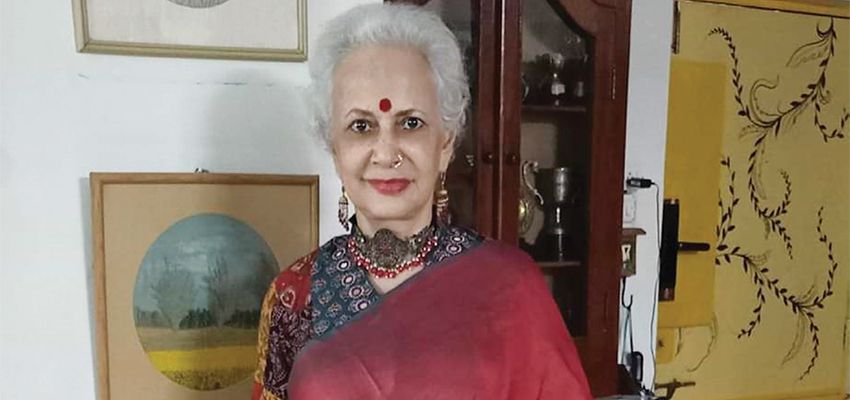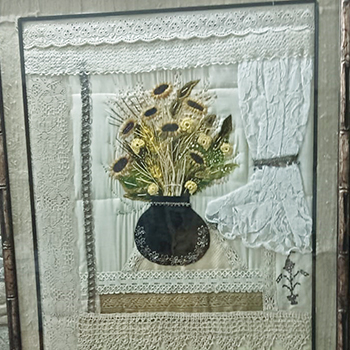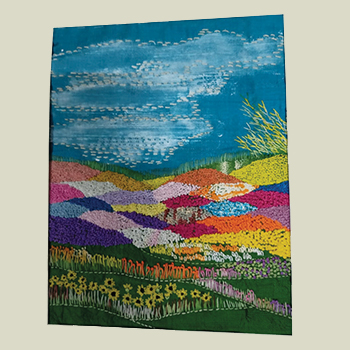Vibrant strokes of diversity

If art is about breaking boundaries, Rizwana Kashyap has done so many times over. At 73, the multimedia artist who embroiders, stitches, patches, and paints like a dream, whilst also being a bonsai maker, book writer and baker of repute—simply refuses to be reined in. For not only has she created things of beauty and joy, she has empowered women to find their feet through her training workshops and institutes—both in her capacity as wife to Kamal Kashyap, former police commissioner of Pune city and Director General of Maharashtra Police, as well as a well-known fashionista, craftswoman and patron of artisans in her own right
Leonardo da Vinci famously said: Painting is poetry that is seen rather than felt, and poetry is painting that is felt rather than seen.
Rizwana Kashyap would go a step further. The sheer range of this multimedia artist’s repertoire is jaw-dropping to say the least. Embroiderer extraordinaire, patchwork expert, bonsai and landscaping specialist, a veritable feast for the eyes. As if that weren’t enough, her baking cakes, cookies, and meringues, nourishes the soul. All of this for well over half a century without flagging.
In a world that prizes symmetry, her very persona makes a case for the opposite. “For me, art has never been about symmetry,” she avers. “Instead, it is about bringing disparate elements together such that they look beautiful and harmonious,” she says.
Dressed in a colourful yellow Kota cotton saree with a dash of red and white in the body— courtesy the dupattas she has joined to the saree, paired with a contrasting green blouse—she exudes individuality by the spades. “Where is the individuality in simply matching elements of your attire or your artwork?” she shrugs. “What an opportunity lost to push the envelope and express yourself in your unique way,” she adds.
In precisely that spirit, astonishing things come to life, as amply depicted by her wall spaces and artistically done up home. A framed sunset of assorted hues that look like a painting but are actually fabric pieced together with such delicacy and deftness as only a maestro could bring to the task — embroidered Gulmohar trees, as also birds and flowers and huts, patchwork quilts and sheets and sofa cushions, sarees with borders from other sarees, abundant lavender blossoms and pretty cottages with grass and garden—all of this, the gift of an unerring eye for detail.
“The other day I was trying to create the bark of a tree by piecing different pieces of cloth together.
Someone asked me why I didn’t choose to go only with brown shades; to which I asked to them to look closely at the bark of a tree—it looks like it is made of different shades in different lights. So how could I use only one colour?” she counters.
Or for that matter a single medium. Her wall pieces are a stunning mix of painting, fabric work and embroidery.
Simply put, all creativity is about observation. That, and one more indispensable ingredient — pain. “It is pain and suffering that converts craft to art. Craftsmanship is simply about technique, but art has a soul,” she says.
"For me, art has never been about symmetry. Instead, it is about bringing disparate elements together such that they look beautiful and harmonious"
-Rizwana Kashyap
The green wells of childhood
 Sunflowers and the lace of good hope
Sunflowers and the lace of good hope
Born in Baroda, Lakshmi Rizwana (named so for being born on Lakshmi Pujan in Diwali) benefitted greatly from assorted influences. Born in a joint family of farmers and freedom fighters, the family was educated, cosmopolitan and forward thinking
“My grandparents received a telegram that a baby girl had been born. Thrilled, they gave `25-a healthy amount then-to the postman. The postman assumed that a grandson had been born, hence the fat baksheesh. But, my grandmother corrected him, that a girl had been born, that too on the auspicious occasion of Lakshmi Pujan. Hence, she was going to name me Lakshmi Rizwana,” she reminisces.
“Despite coming from an aristocratic Muslim background, my grandparents deliberately chose a farmer’s life. They planted fruits and grains, and were pretty connected to the earth—Gandhians to the core. There were no obvious trappings of wealth. We lived simply, and used our hands and innovation to make the best of whatever resources were on hand,” she reminisces. “At the same time, they were progressive and inclusive, refusing to follow the societal notions of high and low-born. They believed in treating everyone with respect,” she adds.
 Thousands of French knots make
Thousands of French knots make this award winning tapestry
Even as she watched her mother and grandmother stitch, bake and garden with aplomb, she learnt at their knee. “Both of them had a great aesthetic sense; they instinctively knew what elements went well together. Most people just couldn’t believe that the little frocks my mother stitched for me were handmade. So neat was the work and finish that they looked imported,” she shares.
There was a sewing machine and a magical rag bag, from which both her mother and grandmother pulled out little pieces of colourful cloth that they would patch into quilts and sheets and bags. Mesmerised, nine-year-old Rizwana decided to try her hand too. “I stitched a blouse for our domestic help’s daughter, and then a skirt,” she says
Despite being so young, not for a minute did she believe she would go wrong. “Just as this generation is tech-savvy enough to be confident that they can make any gadget work, so too, were we instinctively comfortable with the sewing machine and the process of cutting and sewing fabric,” she smiles. “It helped that our elders weren’t overly concerned about us ruining things. Besides, we lived in a culture that prized the art of recycling and renovating,” she says.
Marriage to a policeman meant postings in different areas of Maharashtra. Despite the tedium of running a home and bringing up kids with zero help, Rizwana devoted every free moment to embroidery, painting, sewing, baking, and landscaping. What’s more, she passed it on to eager audiences of women, young and old. She says, “One time, I happened to visit a beauty parlour where mothers like me were having a hard time getting anything done due to their little children, who typical of their age, just refused to sit still. I suggested to the owner that I would put a glass case full of baked cakes and cookies for sale—who knows it might just amuse them.”
To that end, she came up with cakes baked inside kulfi moulds held together by colourful candy sticks, cookies with hearts of jam and chocolate and lots more. The little ones wanted more and more.
Art that gives back
And, the rest is history. From her bonsais and rock-cut landcapes that won prizes in exhibitions, to orders pouring in for cakes and embroidered wall-pieces, Rizwana’s life is all about art. But it is art that gives back, in her support of embroideries and handlooms, in her garden that brought back the birdies (she sent a video to a botanical society explaining how she achieved the return of rarely seen birds in a city), in the people she brought together. “Creating something is like meditation. This is particularly true of embroidery,” she says, as you marvel at the tatted place mats in her home, the beautiful silver Zari from gowns and sarees of yore that she has framed for posterity in a design reminiscent of a fairy tale princess’ room, the colourful corner that she has replicated from a long ago visit to her grandmom’s mayka, the flower pot full of sunflowers with a lace curtain gently falling over it, floral patch in raw silk, and much more, besides.
Apart from being an artist herself Rizwana is also an enthusiastic patron of handlooms and indigenous art forms. “Make sure to support our local weavers, artists, and craftsmen. Don’t bargain with them; it’s not fair to the artist or their commitment. What’s more, to lose an art form is to lose an important bit of our heritage,” she says.
Living as we do in times where machine made, assembly line productions are the norm, it is heartwarming indeed to see a solid case for handcrafted beauty. “You don’t need expensive things to create either. Just recycle the old dupattas and sarees and odds and ends and let your imagination soar. Throw away the plastic, and bring in cloth bags, even for gifts,” she urges.
After all, your imagination creates your reality.